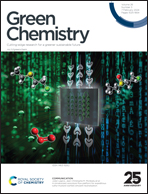A highly active and chemoselective homobimetallic ruthenium catalyst for one-pot reductive amination in water†
Abstract
The first ever homobimetallic catalyst which efficiently catalyzes the reductive amination (RA) reaction of carbonyl compounds in water is described herein. Two new Ru(II) compounds, homobimetallic [(p-cymene)2(RuCl)2L1] (Ru1) and monometallic [(p-cymene)(RuCl)L2] (Ru2) (where L1 = 2,2′-((1E,1′E)-((3,3′,5,5′-tetraisopropyl-[1,1′-biphenyl]-4,4′diyl)bis-(azaneylylidene))bis(methaneylylidene))diphenoxide) and L2 = (2,6-(((diisopropylphenyl)-imino)methyl)phenoxide) incorporating Schiff-base ligands have been synthesized and characterized by various spectroscopic and analytical techniques. Their molecular structures have been deduced by X-ray diffraction measurements. Both complexes, which are water/air stable at room temperature as well as at high temperature, were employed as catalysts for RA in aqueous media using formate buffer as the hydrogen source. Complex Ru1, in the presence of formic acid/formate buffer as the hydrogen source, catalyzes one-pot RA production of secondary amines in ∼99% yield with just 0.05 mol% of the catalyst exhibiting a turnover number (TON) of 1920 and a turnover frequency (TOF) of 480 h−1. When the catalyst loading was further reduced to 0.0001 mol%, the highest reported TON and TOF for any RA reactions were observed (4.3 × 104 and 107 × 103 h−1, respectively), albeit with reduced selectivity. A comparative study between Ru1 and Ru2 reveals that complex Ru1 is more chemo-selective for the formation of a secondary amine, attributable to a cooperative effect. This cooperative effect is further substantiated through extensive computational methodologies involving Density Functional Theory (DFT) calculations on both bimetallic and monometallic Ru(II) complexes along a hybrid-model complex.



 Please wait while we load your content...
Please wait while we load your content...